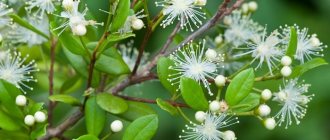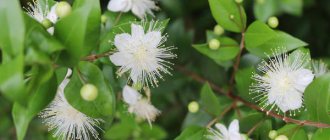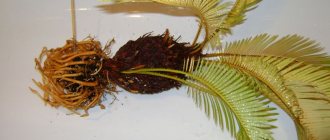/Accessories and decor/Gardening/
Planting a tree and caring for it is a dream that can be fulfilled right now and right in your apartment. Beware: after this article, you are very likely to fall in love with an evergreen tree with a euphonious name and a trail of beautiful stories and traditions!
- The myrtle tree is a small staunch fighter for air purity and the destruction of microbes, an assistant in the treatment of viral diseases. In addition, the plant looks very aesthetically pleasing: a green crown and lush buds during the flowering period.
There are many types of myrtle, varying in leaf size, shape and color. However, at home, the most commonly grown myrtle (Myrtus communis)
And here is a photo of an indoor myrtle in bloom.
View this post on Instagram
Handsome Myrtle in bloom) #myrtle #flowers #flowerinpot #flowerbloomingonthewindow #flowersinthehouse
Posted by Mila Mitina (@mila.mitina.73) Jun 10, 2022 at 11:21 PDT
Contrary to popular belief, myrtle is quite unpretentious: it loves good diffused lighting, timely watering as the soil dries out, spraying in warm periods and fresh air. In order for the tree to have a neat ball shape (such trees are also called topiaries), it needs annual pruning. Further in the article you will find everything about caring for myrtle at home, interesting information about the history of the plant, as well as a photo gallery of myrtle topiary in the interior.
Lighting
The plant will feel great on a western or eastern window: myrtle likes bright light, but not direct rays. If the myrtle tree will be flooded with very intense light from the south side or stand on a south balcony, you will need to slightly shade the bush (especially in the midday sun). On the north side the tree will not bloom well.
Watering
The main indicator for watering myrtle is drying out of the soil. As soon as the layer begins to dry out a little, water the tree with settled water.
- In summer, the approximate schedule for watering and spraying is once every 2-3 days, in winter - less often.
If you make a mistake and forget about watering the myrtle for a very long time, as an emergency measure, you can immerse it along with the soil in water, and then let the rest drain onto a tray.
See also:
- Caring for indoor hydrangea at home
- How to care for money tree (crassula) at home
- How to care for hibiscus (indoor Chinese rose) at home
- How to care for begonia at home
- How to care for Schefflera at home
- Anthurium - home care guide
- How to care for dracaena at home
- Caring for Zamioculcas (dollar tree) at home
- How to care for Kalanchoe at home
- Tree in the room: how to care for Ficus Benjamin at home
- How to care for geraniums at home - a guide for beginners
- How to care for orchids - 7 steps for a beginner
- How to care for violets at home
Myrtle vulgaris: how to care for it? + PROPERTIES!
We consider caring for myrtle at home: watering, replanting, propagation, growing conditions and growing from seeds. We will also tell you the beneficial and medicinal properties of myrtle, for which it is especially loved!
Common myrtle: home care
Myrtle is a beautiful and useful indoor plant. In our homes, the most common myrtle (Myrtus communis) or small-leaved myrtle (Myrtus microphylla) and hybrid varieties bred on their basis are found.
At home, myrtle usually grows 60-90 cm in height. The leaves are small and juicy, the flowers are small, fragrant, white, and the fruits are spicy, juicy, dark blue.
For fruiting, flowers are pollinated by hand with a brush. Myrtle begins to bloom in early summer, and seeds from the ripened fruits can be used for propagation.
At home, myrtle develops well and is a fairly unpretentious plant. Caring for myrtle is not difficult, and in return it brings beauty and benefits to the house.
LIGHTING. For the development of myrtle, a sufficient amount of bright and diffused light is needed; it tolerates a small amount of direct sunlight. At the peak of the summer heat, it is still better to shade it.
- Myrtle communis practically does not bloom in a shady place. West, southwest or southeast windows are ideal. Therefore, in winter, myrtle needs additional lighting, from approximately 17.00 to 22.00.
TEMPERATURE. Myrtle feels good in cool rooms (12-18 degrees) and in rooms with standard room temperature (20-25 degrees), and in winter, during the dormant period, for abundant flowering it is better to keep it at a temperature of 7-9 degrees (glazed, not heated balcony).
If the room temperature is higher, then the myrtle is simply watered or sprayed more often, but the quality of flowering will be worse or will not bloom at all.
In winter, myrtle has a dormant period, which lasts from one and a half to three months, depending on wintering conditions (temperature, light).
SUBSTRATE. For myrtle, you can prepare the soil mixture yourself: take one part each of sand, peat and humus and two parts of turf soil. You can also grow myrtle in a universal substrate.
WATERING. Watering plays an important role in caring for myrtle. Myrtle loves moisture, so it needs to be watered regularly, especially in spring and summer.
At this time, the substrate must be constantly kept moist, but the myrtle should not be “overwatered.” During the rest of the year, watering is reduced and the plant is watered after the top layer of soil has dried 1-2 cm.
- It turns out that in the summer about every 3-4 days, and in the winter every 6-7 days the myrtle is watered. In addition, in spring and summer, myrtle is sprayed every day or two, and in winter only in case of active operation of heating devices that dry the air.
More destructive for myrtle is an excess of moisture, which causes the roots to rot and fungal diseases and bacteria to appear.
For watering and spraying, it is advisable to use soft water at room temperature.
How to care for myrtle? Feeding, pruning, replanting, propagation
FEEDING. In spring and summer, myrtle needs nutrients. During active growth, it is fed every two weeks.
For the flowering form - fertilizer for flowering plants, for myrtle-bonsai - fertilizer for decorative deciduous species. During the rest of the year, you should not feed myrtle.
TRIM. With the help of pruning, myrtle can be given unusual and original shapes, for example, grown like a bonsai.
To form a denser crown, young shoots of myrtle are pinched. It is better to prune myrtle in the spring, and pinch it depending on need.
TRANSFER. A young plant needs to be replanted every year, and adults (from 4 years old) every 2-3 years. Favorable time is the beginning of spring.
REPRODUCTION. Myrtle is propagated by seeds and cuttings. It is easier and simpler to propagate myrtle from cuttings.
- In spring or early summer, cut off the tops with 3-4 pairs of leaves of non-flowering shoots from the bottom or middle of the bush.
- The resulting cuttings are planted in a sandy-peat substrate and covered with film or glass on top. The seedlings are ventilated daily and kept in a shady but warm place.
- New shoots appear in about 25-35 days. After this, the myrtle is moved to a brighter place and standard care is applied. After 2-3 years the plant begins to bloom.
It is good to take cuttings after pruning from people whose myrtle you liked. They don’t mind and it’s easy for you to start a new variety.
GROWING FROM SEEDS
Propagation by myrtle seeds is often less successful.
- In spring, fresh myrtle seeds are washed in potassium permanganate, dried and planted in prepared soil to a depth of 5 mm and covered with film.
- The container is placed in a warm and bright place without bright sun, ventilated daily and moistened with a spray bottle.
- Seeds sprout in 30-45 days. The film is removed and after 10-15 days the seedlings are transplanted.
- When the myrtle grows to 15-20 cm, it is pinched to stimulate growth.
- The plant blooms in the 5th-6th year and may not retain varietal characteristics.
DISEASES and PESTS. Regular care of myrtle (proper watering) minimizes the risk of disease and pest damage.
Very rarely, myrtle is affected by aphids , scale insects or spider mites . Regularly inspect the plant through a magnifying glass and, if found, treat the myrtle with a soap solution (mite) or an insecticide (actellik or actara).
Repeat the treatment every week until all pests are eliminated. The treatment should be carried out in the fresh air, having previously covered the substrate in the pot with film.
Useful and medicinal properties of myrtle:
The healing properties of myrtle have been known to mankind for a very long time. Due to its beneficial properties, myrtle is very popular and loved, especially among women. We described the properties of myrtle for the family in the addition to the article at the top.
- sacred tree in ancient greece
- in Northern Europe, a talisman for the mistress of the house
- myrtle was planted during the birth of a daughter, and at the time of her marriage, the veil and wedding bouquet were decorated with branches of this particular tree
- essential oils from the leaves, bark and flowers of myrtle are used in perfumery and medicine
- infusions and decoctions strengthen the immune system and treat many ailments at the initial stage
- Soviet scientists developed a myrtle tincture that was good for treating pneumonia, diabetes and chronic bronchitis
- Myrtle leaves can be used to wrap meat when frying.
- a sprig of myrtle is added to the firewood when baking, smoking or grilling meat or fish for a special aroma
INTERESTING ON THE TOPIC:
Here is a myrtle, caring for it at home is not burdensome, but it brings beauty and peace to the house.
We wish you a cozy atmosphere in your home and many smiles!
Top dressing
In order for the plant to grow (especially if you want to grow a real large tree in a tub), you need to add fertilizing to the myrtle menu. As always, this is done in the spring and summer. Stick to a weekly fertilizer addition schedule. Thus, you will need to feed the tree 24 times during the warm season. There is no need to fertilize the soil in autumn and winter!
- The myrtle “diet” is completely satisfied with universal complex fertilizers for deciduous trees, which are available in any specialized stores.
Trimming
A tree as round as a lollipop is not the original type of myrtle: this is how it is formed when pruned. If the bush is started, it will have a pyramidal crown shape with a thickened bottom.
An important point: the more often you prune, the less often the myrtle will bloom. So decide for yourself what will please the eye more: flowers or a green crown.
Pruning is done with pruning shears or garden shears. The best time of year for this procedure is spring.
- Watch the density of the plant: myrtle will not like pruning too often due to the weak trunk.
With rational pruning and the whole sum of favorable factors given in the article, myrtle can grow in a couple of years to the state of a beautiful lush tree, which can already be planted in a floor tub.
By the way, some plant growers go further and, using pruning, make dwarf bonsai varieties from myrtle. It turns out quite successfully! To do this, the trunk is pruned to achieve bushiness, and the plant itself is transplanted into a wide and flat pot, covering the soil with moss.
View this post on Instagram










